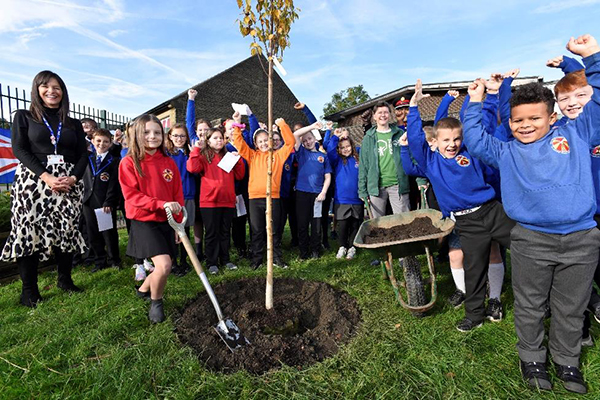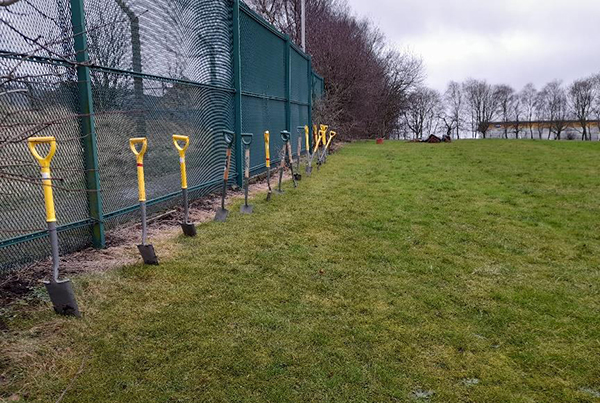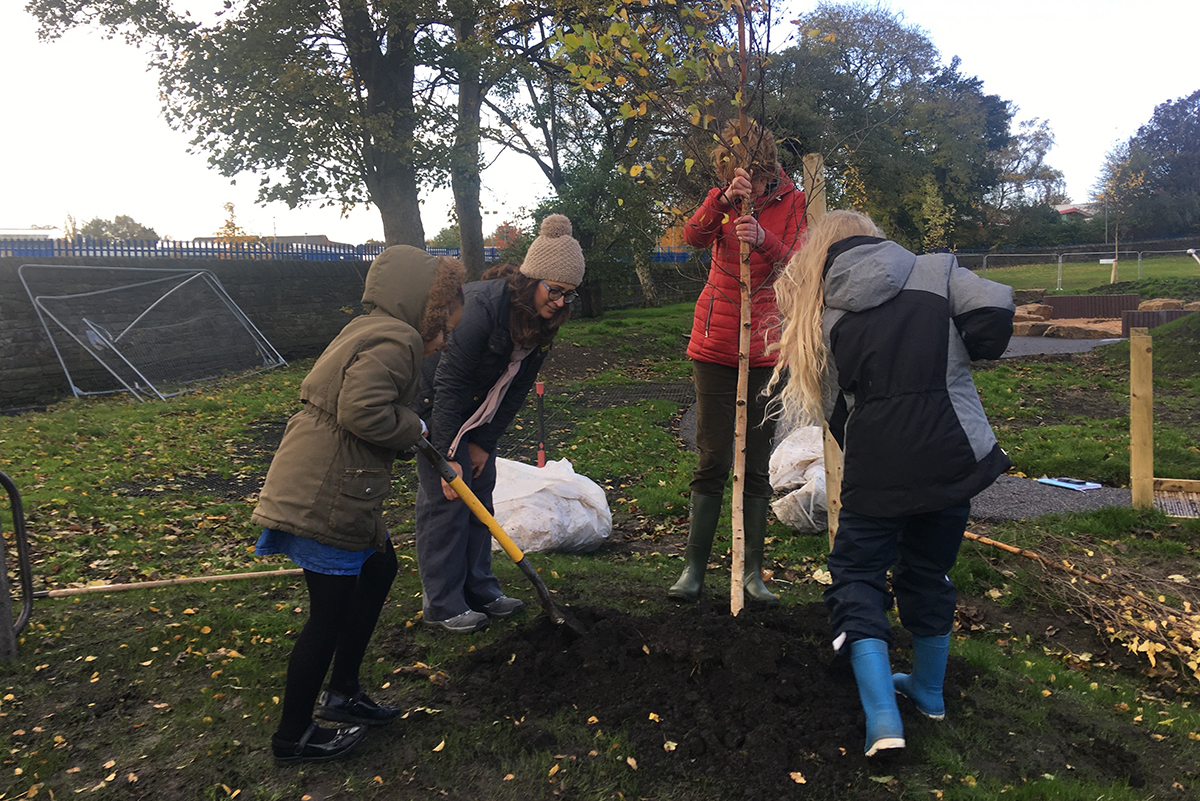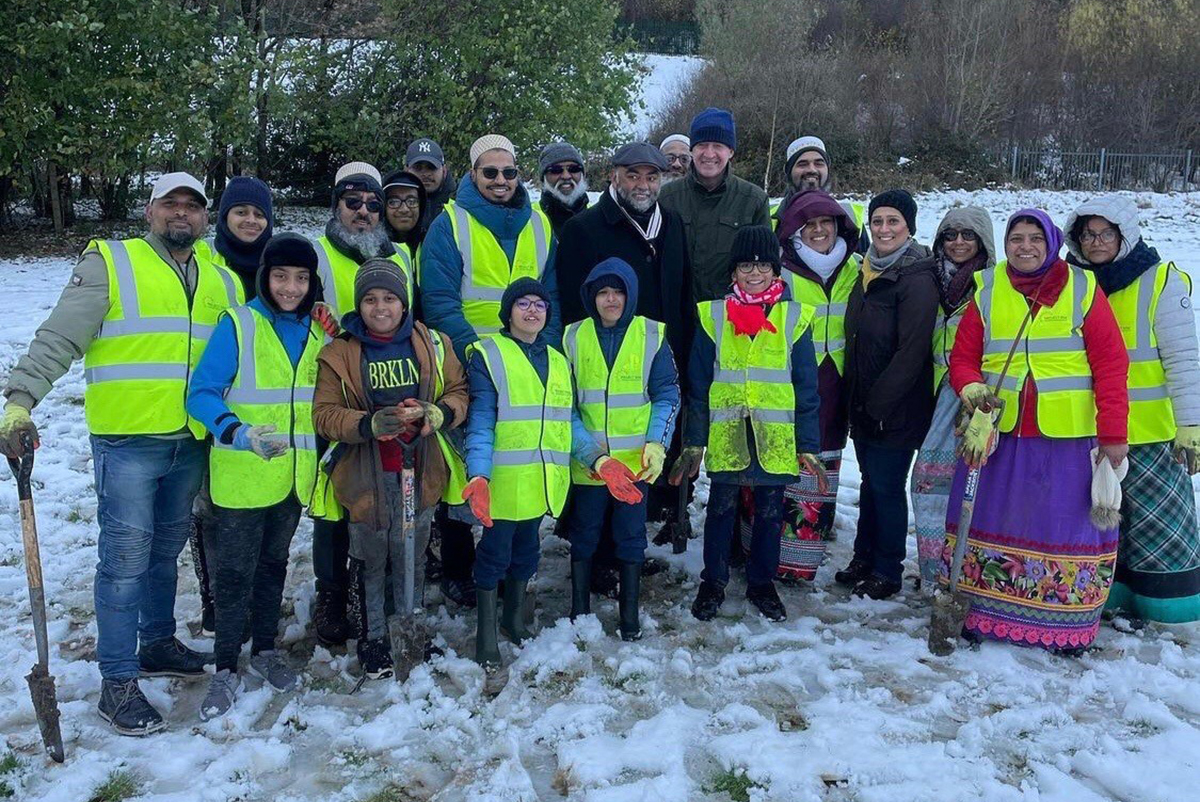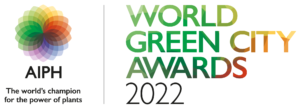Addressing the urban challenge
Breadth of the issue – How are the problem(s) that are being tackled by your initiative affecting citizens/local businesses or a significant component of the local wildlife?
Climate change is a growing threat to the planet and people. Bradford Council declared a climate emergency in 2019 to take action and reduce carbon emissions to net-zero by 2038 to help reduce environmental threats. Planting trees is a major factor in tackling climate change – a single tree can absorb 22 kg of carbon dioxide per year and 100 square metres of woodland can store nearly four tonnes. Trees also assist in flood resilience, by helping to absorb and evaporate rain, as well as slowing the rate at which rainwater enters our watercourses and drainage systems – nature based solutions in sustainable drainage systems.
The UK Government’s A Green Future: Our 25 Year Plan to Improve the Environment (2018) states that “Having more trees in and around our town and cities, close to where people live and work, brings people closer to nature and improves air quality, with consequent positive health impacts”.
Work conducted by the Bradford Institute for Health Research shows that within Bradford’s deprived communities, improved access, and availability to high quality green spaces to enhances physical and mental health.
Depth of the issue – How seriously are the problems being tackled by your initiative impacting the life of the citizens/businesses/wildlife concerned?
As well as planting trees to help climate change mitigation, the strength of Bradford’s tree planting and green space regeneration projects is in how they engage the community.
Projects involve volunteers and community stakeholders in tree planting as a visible statement of Bradford’s ambitions to respond to climate change. This work is not remote or obscure, but tangible, relevant and in our neighbourhoods. The projects link to school trees and orchards brings an educational value to the work, helping to develop the curriculum.
The use of native trees species increases the biodiversity, but also the way that green space regeneration is creating steppingstones for birds and pollinators to move around our urban neighbourhoods is improving our natural environment.
Increasing the amount of trees and plants in our most congested urban neighbourhoods also helps with improving air quality.
The power of plants and natural ecosystems to deliver benefits
How is the initiative shaped by scientific evidence of the potential for plants and natural ecosystems to deliver benefits?
Making the direct link that each child has a tree planted for them is making the projects more personal and inspirational to our young, who will inherit the effects of climate change if we do not act.
Our green space regeneration projects use co-design and co-creation to ensure community agency in the work. They are invested in the decisions made and therefore take ownership of the outcomes and value the projects more. The green space regeneration is enabling some of our most challenged ethic communities to come together, with a shared purpose, that offers social cohesion and the added value is achieved through coming together outdoors for health and well-being.
Much of the tree planting has been delivered by a large volunteer group, which has again focused on bringing children into the project. If taking part in planting trees inspires our children to help address climate change, we are enriched as a society.
Bradford Council declared a climate emergency in 2019 and our tree planting and green space regeneration innovatively combines a desire to mitigate climate change, with the empowerment of our diverse communities to come together in enjoying all the benefits of a green city.
How has the city exploited the potential of plants and associated ecosystems to deliver more than one benefit?
Bradford’s tree planting and green space regeneration is a collaboration of key local authority services, such as the Trees & Woodlands Team, Countryside Team, Landscape Design & Conservation, Parks, Highways, Social Work, Community Outreach/Ward Officers, Public Health and Active Travel specialists, with third sector agencies such as Trees for Cities, Forest of Bradford (part of Bradford Environmental Education Service), Bradford Environmental Action Trust, Fruit Works, YORgreencic. The support of colleagues and researchers in our National Health Service partners and links made to schools has helped shape the project, but fundamentally it is the collaboration with our diverse communities that drives this work.
Innovation is being achieved in just how many stakeholders have been brought together with the public to inspire this work.
Innovative and Collaborative Solution
How does the initiative show evidence of feasibility, including on-going financial and logistical support?
Despite Bradford District being two thirds rural, its urban core is the most affected by social deprivation and a lack of access to green space. Our urban environments are largely shaped by rapid industrialisation of the wool industry in the nineteenth century and are also the most at risk of the effects of climate change. They have the most densely populate housing stock in the district and the poorest air quality, necessitating the introduction of a Clean Air Zone later this year.
The social challenges Bradford is responding to are undeniable. Bradford District is ranked 5th most income deprived and 6th most employment deprived local authority in England
- 15% of the District’s households are in fuel poverty
- 22% of children are living below the poverty line
- 13% of working age people have no qualifications
- 11% of the working age population claim an out-of-work benefit
14 of the District’s wards are amongst the 10% most deprived wards in England, and it is in these neighbourhoods that much of the green space regeneration is taking place.
Planting trees and regenerating undervalued open space for community use will not eliminate climate change or solve all our societal challenges, but creating a greener city is contributing to a better and brighter future.
In what ways is the initiative innovative?
Work conducted by the Bradford Institute for Health Research is considering green space provision and use in Bradford. This research identifies that in Bradford’s communities’ access to green space is not as inclusive as it needs to be –
- South Asian families tend to have less green spaces in their local environment and what there is tends to be of poorer quality.
- South Asian families are less satisfied with their local green spaces than White British Families.
- South Asian children spend less time playing in green spaces that White British children.
Bradford District has the largest proportion of people of Pakistani ethnic origin (20%) in England. The proportion of South Asian families is highest in our urban neighbourhoods. In Bradford, 55% of the population are exposed to levels of air pollution above EU exposure guidelines.
Women born in the most deprived areas can expect to live an average 9 years less than the average and for men it is 11 years less. The urban inner-city wards have the lowest life expectancies, whereas the outer rural wards of have the highest life expectancies. Our urban areas are the focus for green space regeneration, to help address the inequalities in our society.
Climate change is also affecting our citizens, with localised flash flooding becoming a more common event.
How is the initiative supported by collaborative working across disciplines and sectors?
Bradford Council’s Trees and Woodlands Team to monitor the main tree planting activity as part of the Tree for Every Child initiative, but each community project will have a working party of all the main stakeholders to monitor progress.
Progress on all projects is reported to the Council for scrutiny.
Monitoring of some green space projects also comes from public health partners such as Born in Bradford, as part of research into the links between green space and better public health outcomes for our communities.
Monitoring by third sector partners, such as Trees for Cities, Forest of Bradford (part of Bradford Environmental Education Service), Bradford Environmental Action Trust, Fruit Works will also explore how what is achieved relates to their specific objectives.
How does the initiative demonstrate evidence of community support?
The total number of trees planted to date is 28,000, leaving approximately 27,000 to plant 2022/23.
20 School Orchards with training sessions have been delivered, 20 more programmed for 2022/23.
25 in-school tree, wood and hedge planting events delivered, 20 more programmed for 2022/23.
2000 trees have been handed out to schools and families.
Progress is shared with the media, and it has been covered on national television by the BBC Countryfile programme. Lots of social media posts share updates on activity to widen the audience reached.
Implementation, Impact and Replicability
How does the initiative demonstrate evidence of a track record of success against pursued objectives?
The Council has invested £250,000 into the Tree for Every Child initiative. The programme is being supported by Trees for Cities which is funded by The Dulverton Trust, The Prince of Wales’s Charitable Fund and The Arbor Day Foundation. As well as the players of the Postcode Lottery.
Green space regeneration is being delivered from a variety of resources and funders, reflecting the success of the Bradford promoting its ambitions and drawing in provision.Support for community groups comes from with the local authority, but also our third sector partners and local stakeholders. This covers both the logistics of delivering projects, but also the educational support to train people how to plant and manage trees, the impact this has on climate change mitigation, and how they can work together as a community.
Many green infrastructure sites are in the public realm and benefit from maintenance support from the local authority, but assistance is also being provided to community groups to manage sites and build capacity to become resilient and self-supporting. It is about enabling diverse communities to become more cohesive by their shared passion for a green city.
How has the initiative had a ripple effect beyond the scope of the initiative itself, thereby demonstrating a change in the city’s and/or its partners’ way of working with plants?
100s of volunteers and 1000s of students have been connected to the Tree for Every Child initiative, which could not exist without community support.
At Attock Park, the new community garden brought Bradford Moor’s Play and Support Service, which runs a range of activities and projects to engage and support the community, and the Council’s Landscape Design & Conservation Team, Public Health Team, and the Better Place Bradford initiative, together with the local community, to co-design and co-create the project. Attock Park is named after the city in Pakistan’s Punjab, and reflects the historic links this Bradford community has to that region. The Queens Award for Voluntary Service was awarded to people working within this community at the opening ceremony for the park.
How have other cities expressed interest in the initiative, or what potential does it have to interest other cities and be customised to their own circumstances?
The choice of site for tree planting had developed during the life of the Tree for Every Child Initiative, with community groups being offered the opportunity to suggest locations.
Rewarding new relationships within our communities have been forged.
Sustainability and Resilience
What efforts have been made to reduce the carbon footprint of the initiative?
Community Groups are being capacity to become more resilient and to consider what more can be achieved. The rewards of fulfilling ambitions are being recognised, and built upon to increase community cohesion.
The district is seeing an increased demand for trees in urban areas form the public, and project teams are exploring and increased use of nature-based solutions in our public realm improvement projects.
Research to explore social prescribing of our green space, and empowering communities to set up projects that helps connect people with nature for health and well-being, have begun. Nature’s Way is an 18-month design research project on Nature Based Solutions which has Bradford collaborating with the Royal College of Art, University of Sheffield and Mind Kind Projects. More info.
The power of tree planting has been able to bring in significant media interest, including being featured on the celebrated BBC Countryfield programme.
How have the anticipated impacts of climate change been considered?
Bradford’s tree planting and green space regeneration has been able to link into wider regional projects, such as the White Rose Forest across North and West Yorkshire, and national projects such as the Queen’s Green Canopy.
Bradford Council has also used its involved in international city to city learning networks to spread the story of what is being achieved. Interreg BEGIN (Blue Green Infrastructures through Social Innovation) looks at how cities can improve climate resilience with Blue Green Infrastructure involving stakeholders in a value-based decision-making process and has grown to consider how the same intervention can also create better public health and well-being outcomes. URBACT Healthy Cities Action Planning network aims to deepen the relationship between health and the urban environment, planning actions that focus on improving the population’s health.
A new project delivered through the EU Horizon programme is Life CRITICAL. Promoting and improving the multiple environmental and health benefits of urban green spaces, Life CRITICAL (Climate Resilience Through Involvement of Local citizens) aims to provide resilience to climate change for local neighbourhoods.
Life CRITICAL is engaging communities, raising awareness of healthy lifestyles and showing how Horton Park can provide environmental improvements that address challenges such as air pollution, urban heat island effects and localised surface water flooding.
What processes does the initiative include for it to be considerate in its use of soils and other natural resources?
The use of volunteers in tree planting has a positive impact on the sustainability of projects, but fundamentally an initiative like Tree for Every Children has a low carbon footprint, by its very nature.
In more complex green space regeneration projects, where possible local suppliers and materials are prioritised through procurement.
Working on seasonal planting helps mitigate the need for additional watering and maintenance during establishment, reducing the need for site visits.
Monitoring, Maintenance, and Management
How has the initiative been designed and implemented so that long-term needs for management and maintenance are reduced and can be met?
Tree and plant selection focuses on native species that will be resilient and well adapted to thrive in Bradford’s microclimate, as well as being more beneficial to biodiversity and ecosystem stability.
Tree planting is being delivered seasonally to mitigate the need for watering during establishment, and site selection is avoiding to need to import in new topsoil.
In larger green space regeneration projects, nature-based solutions for sustainable drainage systems are being included in designs.
What protocols are in place to facilitate monitoring of results?
Site and planting species selection is key to minimising long-term management and maintenance needs. Native species will require the least invasive maintenance regimes and be the most resilient.
Community groups are being given support and advice on how to maintain their green assets, but also the educational resources being delivered in schools are creating future community generations better equipped to understand their environment and how to protect it.
How has the initiative been enhanced in response to monitoring of results?
Tree planting activates are sited where the need to import new topsoil can be kept to a minimum, if any is needed at all. The focus is on improving sites naturally.
Green space regeneration projects focus on reuse of brown field sites or where the quality of the natural environment is low and needs to be enhanced for better outcomes.
Even when exploring large regeneration projects Bradford Council’s landscape designers and engineers explore how to move surplus material between sites in the district to improve delivery across a series of projects, rather than export or import material unnecessarily.
Community projects are encouraged to explore rainwater harvesting and recycling.

















